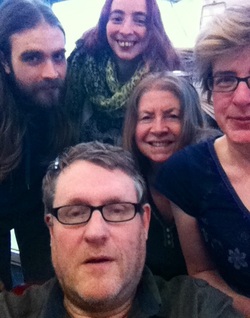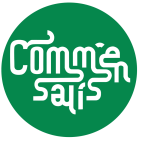‘COMMENSALIS’

'Commensalis' is a group of artists from Wales, Scotland and England. We’re based in South Wales and we love sharing our art with the world, so we’re organising pop-up exhibitions wherever we can. We’ll be doing one in Bath from July the 8th to the 14th this year at the historic Walcot Mortuary Chapel.
Commensalis is Printmaker Kara Seaman, Collagist Melanie Ezra, Photographic artists Owen Martin and Rhys Jones and scribbler and printmaker Rose Davies. Local Bath sculptor and 'Maker' Jeni Wood will be a guest artist for this show.
The word ‘Commensalis’ comes from Medieval Latin and it reflects a commensal relationship, one organism using another for housing, or utilising something created after its death. We are inhabiting a chapel created for the departed. We are using this house of the dead to house our work. Our relationship towards each other is symbiotic.
Commensalis is Printmaker Kara Seaman, Collagist Melanie Ezra, Photographic artists Owen Martin and Rhys Jones and scribbler and printmaker Rose Davies. Local Bath sculptor and 'Maker' Jeni Wood will be a guest artist for this show.
The word ‘Commensalis’ comes from Medieval Latin and it reflects a commensal relationship, one organism using another for housing, or utilising something created after its death. We are inhabiting a chapel created for the departed. We are using this house of the dead to house our work. Our relationship towards each other is symbiotic.
THE VISUAL ARTISTS
Kara Seaman
Kara is a printmaker and illustrator, primarily interested in animals and their interactions with their environments, the humans that surround them and one another. “I love how animals seem to have great characters, and seem very telling in their actions and looks. I am interested in myths and histories that surround many creatures.”
Kara works mainly with collagraphs or watercolour and ink, each piece the result of painstaking and meticulous process, producing atmospheric, sometimes whimsical, pieces that explore the stories animals might tell of their interactions with the human world.
Melanie Ezra
“Most people feel that the world looks like a photograph. I’ve always assumed that the photograph is nearly right, but that little bit by which it misses makes it miss by a mile. This is what I grope at.”
-David Hockney
Small Worlds considers how the photograph fails to see truthfully but, more importantly, how we fail in our memories of this so called truth. We remember aspects of an event as pieces which we build in our minds to create a vision which can be remembered but which is not always accurate. The memory forms like a jigsaw and is pieced together from fragments which do not always fit comfortably.
Small Worlds uses methods of collage to rework the photograph on which it is based. Each Small World is based on one of the artist’s own source photographs. By working with her own imagery the artist questions the veracity and accuracy of a memory of an original experience. Each collage is flawed and unreliable in relating the image upon which it is based; it narrates differing qualities and interpretations on what can be considered the truth. The viewer is enticed into seeing a fragmented assemblage of the pieces of the artist’s mind.
Owen Martin
Owen is a Swansea-based artist, interested in photographing various political, cultural and environmental issues, “I try to take photographs that don't obviously show what they are about.” Owen uses a lot of digital technology to make his work; digital cameras, scanners and printers, computer software along with online sharing and editing tools are pushed to their limits in order to exploit the effects of digital technology, such as digital noise when using high ISOs. “I am interested in using digital technology to create images that look different rather than trying to emulate photographs on film.”
Rhys Jones
Rhys’ current work involves research examining the connections between art and neuroscience, offering some non-scientific accounts of the mysteries of conditions on the autism spectrum. Rhys says, “It is like a journey through a labyrinth both of art and of the mind. On any journey of significance, one needs to make notes of activities and record where one has been.”
Like the Victorians, Rhys often uses the medium of postcards. Although addressed to someone, one never knows exactly who has read it and even if the recipient has received it. “I have an interest in gaining an insight and to understand further what may be happening in our minds and bodies when we engage in an artistic activity when performing other daily routines.” Rhys experiments with different types of photographic devices from different periods of time, each bringing its own quality to the resulting image.
Rose Davies
The exhibition I will be showing is called ‘Rinascere’. It is an Italian word which means ‘to be reborn’ or ‘to revive’. I chose it because I have been deliberately working with Renaissance techniques and materials for some time and the word ‘rinascere’ is the root of the word ‘renaissance’. I also identified with its meaning ‘to revive’ in the light of the current art trends which have moved away from traditional skills such as drawing and etching.
‘Rinascere’ is a body of small works comprising ten solar plate etchings and the eight Renaissance-style drawings that inspired them. It also includes some very large figurative drawings in the ‘manier-noir’ style.
Jeni Wood
Jeni describes herself as a ‘maker’ rather than an artist. Her education and employment – Bath Arts School and then computing showed her interests in design, logic and in the detail of how things work. She did a mid-career Diploma in Art and Design at Bath College of Further Education (1991-94), to her surprise gaining the ‘Student of The Year’ award. It was a logical step to move into paper engineering (with Mathew Price Children’s Books) before going freelance. Child rearing led to toy making and garden sculptures. She likes to sculpt in clay, stone and wood. She also uses found objects and, of course, paper.
For more information please contact us.
Kara Seaman
Kara is a printmaker and illustrator, primarily interested in animals and their interactions with their environments, the humans that surround them and one another. “I love how animals seem to have great characters, and seem very telling in their actions and looks. I am interested in myths and histories that surround many creatures.”
Kara works mainly with collagraphs or watercolour and ink, each piece the result of painstaking and meticulous process, producing atmospheric, sometimes whimsical, pieces that explore the stories animals might tell of their interactions with the human world.
Melanie Ezra
“Most people feel that the world looks like a photograph. I’ve always assumed that the photograph is nearly right, but that little bit by which it misses makes it miss by a mile. This is what I grope at.”
-David Hockney
Small Worlds considers how the photograph fails to see truthfully but, more importantly, how we fail in our memories of this so called truth. We remember aspects of an event as pieces which we build in our minds to create a vision which can be remembered but which is not always accurate. The memory forms like a jigsaw and is pieced together from fragments which do not always fit comfortably.
Small Worlds uses methods of collage to rework the photograph on which it is based. Each Small World is based on one of the artist’s own source photographs. By working with her own imagery the artist questions the veracity and accuracy of a memory of an original experience. Each collage is flawed and unreliable in relating the image upon which it is based; it narrates differing qualities and interpretations on what can be considered the truth. The viewer is enticed into seeing a fragmented assemblage of the pieces of the artist’s mind.
Owen Martin
Owen is a Swansea-based artist, interested in photographing various political, cultural and environmental issues, “I try to take photographs that don't obviously show what they are about.” Owen uses a lot of digital technology to make his work; digital cameras, scanners and printers, computer software along with online sharing and editing tools are pushed to their limits in order to exploit the effects of digital technology, such as digital noise when using high ISOs. “I am interested in using digital technology to create images that look different rather than trying to emulate photographs on film.”
Rhys Jones
Rhys’ current work involves research examining the connections between art and neuroscience, offering some non-scientific accounts of the mysteries of conditions on the autism spectrum. Rhys says, “It is like a journey through a labyrinth both of art and of the mind. On any journey of significance, one needs to make notes of activities and record where one has been.”
Like the Victorians, Rhys often uses the medium of postcards. Although addressed to someone, one never knows exactly who has read it and even if the recipient has received it. “I have an interest in gaining an insight and to understand further what may be happening in our minds and bodies when we engage in an artistic activity when performing other daily routines.” Rhys experiments with different types of photographic devices from different periods of time, each bringing its own quality to the resulting image.
Rose Davies
The exhibition I will be showing is called ‘Rinascere’. It is an Italian word which means ‘to be reborn’ or ‘to revive’. I chose it because I have been deliberately working with Renaissance techniques and materials for some time and the word ‘rinascere’ is the root of the word ‘renaissance’. I also identified with its meaning ‘to revive’ in the light of the current art trends which have moved away from traditional skills such as drawing and etching.
‘Rinascere’ is a body of small works comprising ten solar plate etchings and the eight Renaissance-style drawings that inspired them. It also includes some very large figurative drawings in the ‘manier-noir’ style.
Jeni Wood
Jeni describes herself as a ‘maker’ rather than an artist. Her education and employment – Bath Arts School and then computing showed her interests in design, logic and in the detail of how things work. She did a mid-career Diploma in Art and Design at Bath College of Further Education (1991-94), to her surprise gaining the ‘Student of The Year’ award. It was a logical step to move into paper engineering (with Mathew Price Children’s Books) before going freelance. Child rearing led to toy making and garden sculptures. She likes to sculpt in clay, stone and wood. She also uses found objects and, of course, paper.
For more information please contact us.
